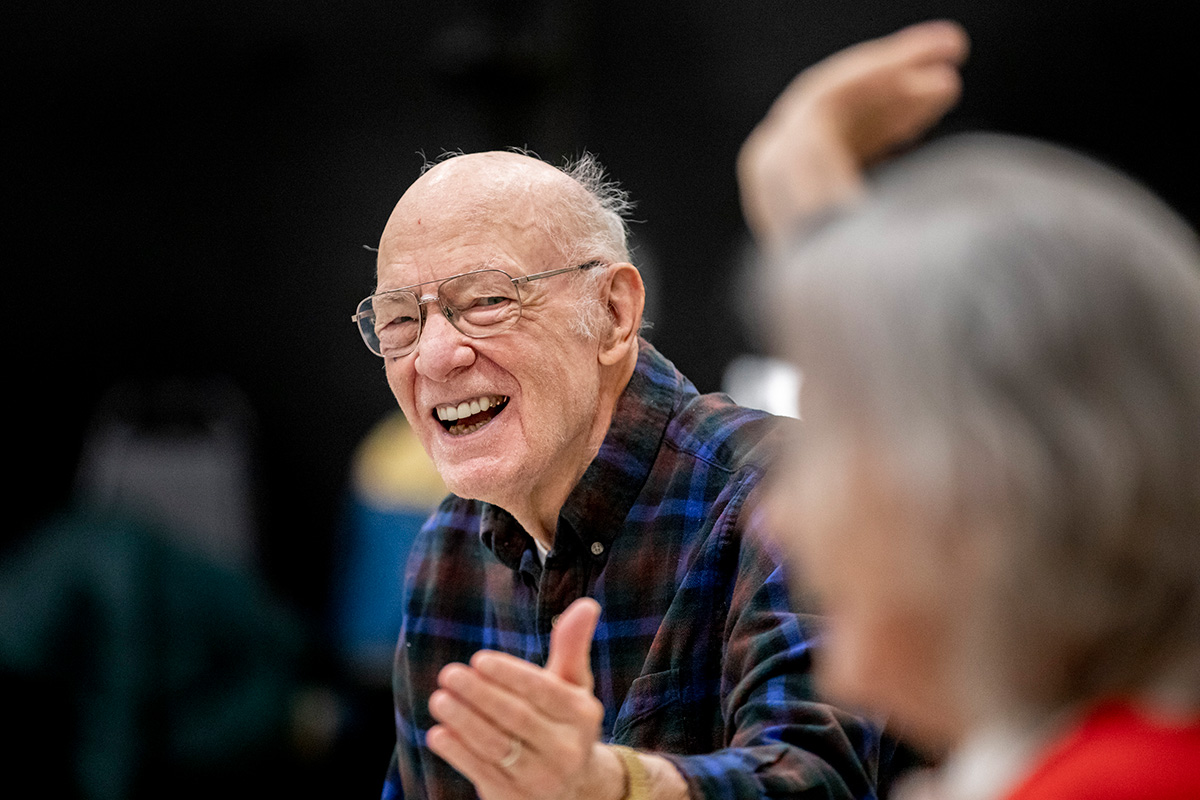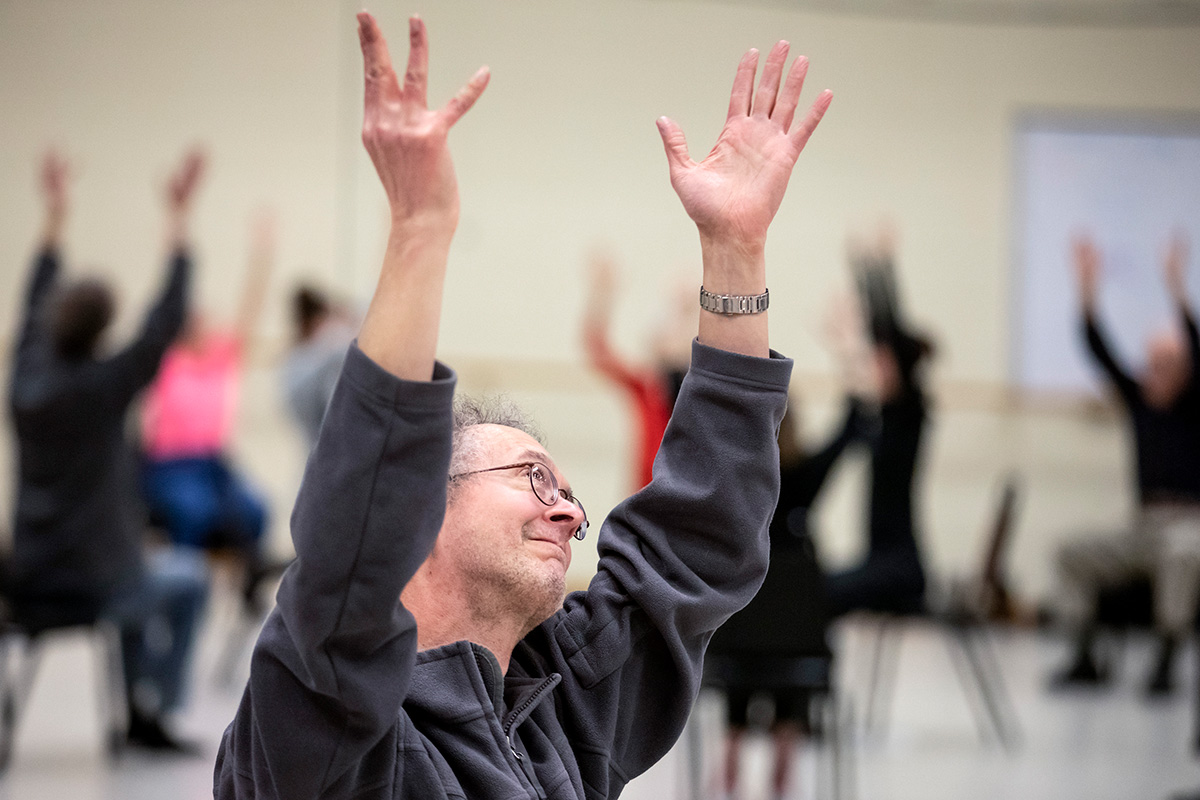
Gary Stitt, 61, stretches his arms to the sky as people gather for a Dance for People with Parkinson's class at Krannert Center for the Performing Arts. The program uses the power of dance and music to inspire patients to expand the limits of their condition. "You just have to keep moving, one way or another," Gary says. "If I ever stop moving, that's the end of it."
Photo by Fred Zwicky
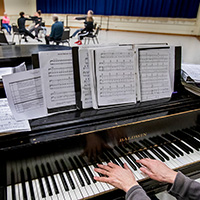
As the Parkinson's dancers move to the music, accompanist Beverly Hillmer finds just the right tune and tempo. "I feel their energy to find expressive freedom," Hillmer says.
Photo by Fred Zwicky
CHAMPAIGN, Ill. – Laughter ripples across the dance floor. Bodies bend in an arc. For some, that arc is much less pronounced, but that's not important. Any expansion of movement is a celebration for these dancers – they have Parkinson's disease.
Piano music echoes down a long corridor from a rehearsal hall in the lower levels of Krannert Center for the Performing Arts while people gather for a monthly session of Dance for People with Parkinson's, a tradition for more than 10 years at the University of Illinois at Urbana-Champaign.
Illinois dance instructor Laura Chiaramonte has a front-row seat to the proceedings.
"What is beautiful to witness is they have no fear," she says. "They go for it. They don't let anything hold them back."
CLICK ON ANY PHOTO TO VIEW SLIDE SHOW

Illinois dance instructor Laura Chiaramonte inspires the dancers to express themselves through movement. "It's really quite amazing to see them be able to start to move in a way that they don't move in their everyday lives," she says. "In Parkinson's, the muscles are constricting and tightening, and they shake. We try to get them to expand out into the body so that they can express a move very differently."
Photo by Fred Zwicky
For these dancers, the challenges can be profound.
"Twenty years ago, I loved to play tennis," says one of the participants, Chris Frichtl, 83, a retired nurse. "I was never good, but I was very motivated. Today, what motivates me is the strong desire to walk again."
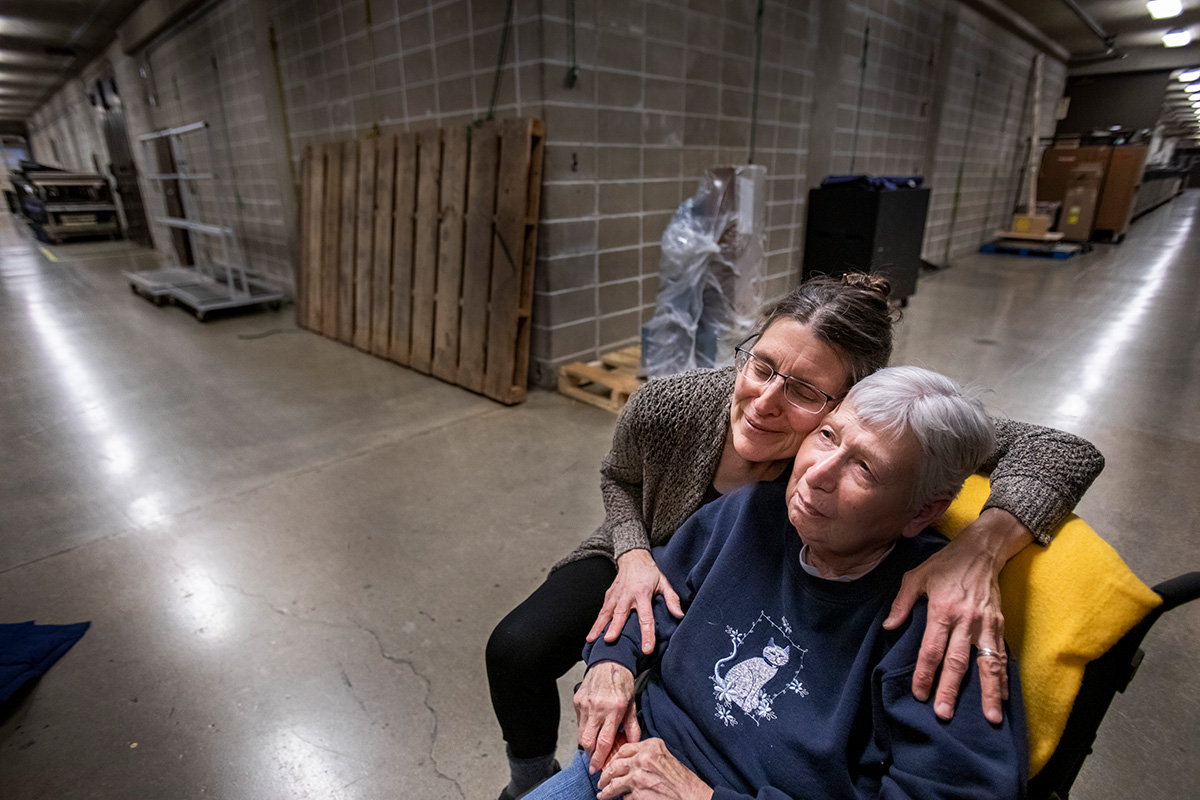
Chris Frichtl, right, says she knows her limitations very well. Today, she is feeling hampered after an aggressive physical therapy session yesterday. Embraced by her caregiver, Jeanine Berlocher, Chris says, "Twenty years ago, I loved to play tennis. I was never good, but I was very motivated. Today, what motivates me is the strong desire to walk again."
Photo by Fred Zwicky
Parkinson's disease is a progressive movement disorder that can lead to impaired balance, tremors, stiffness or slowing of movement. Medically, each person experiences symptoms and disease progression in a different way. According to the National Center for Biotechnology Information at the National Institutes of Health, an estimated 7 to 10 million people have Parkinson's disease.
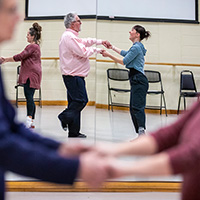
Graham Evans, 77, center left, slides his feet across the dance floor with Laura Chiaramonte, center right. The movement and music create an "unconscious creative place in the mind where you're not thinking about walking, you're dancing," Chiaramonte says.
Photo by Fred Zwicky
I am drawn to photograph this class because I helped manage the care of my dad, Gary, and his Parkinson's disease. Back in the 1960s, when he attended Illinois, Gary Zwicky was the first person to earn a doctorate of music arts in organ. Parkinson's took away his ability to play the organ. And then, miraculously, his gift returned, allowing him to perform again. We've all heard about the power of music to heal. I'm fascinated by the powerful idea of music and dance combined as one therapy.
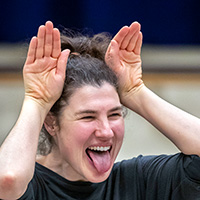
Never short of a quick smile or enthusiastic laugh, co-instructor Kate Insolia makes a playful face as the group creates an improvised call-and-response sequence of moves during a brain-teaser exercise.
Photo by Fred Zwicky
The group starts each session in a large circle, doing a series of movements while seated in chairs. Family members or caregivers often join in. They are welcome to take part in the sessions. Some of the participants use chairs to help stabilize themselves. Others are able to move across the floor but might need a steadying hand. Accompanist Beverly Hillmer adds her own energy to the proceedings. She finds just the right tune and tempo for each dance.
Chiaramonte was trained in the therapeutic dance methods for Parkinson's patients first conceived by the Mark Morris Dance Group, which started the pilot program in Brooklyn, New York, in 2001.
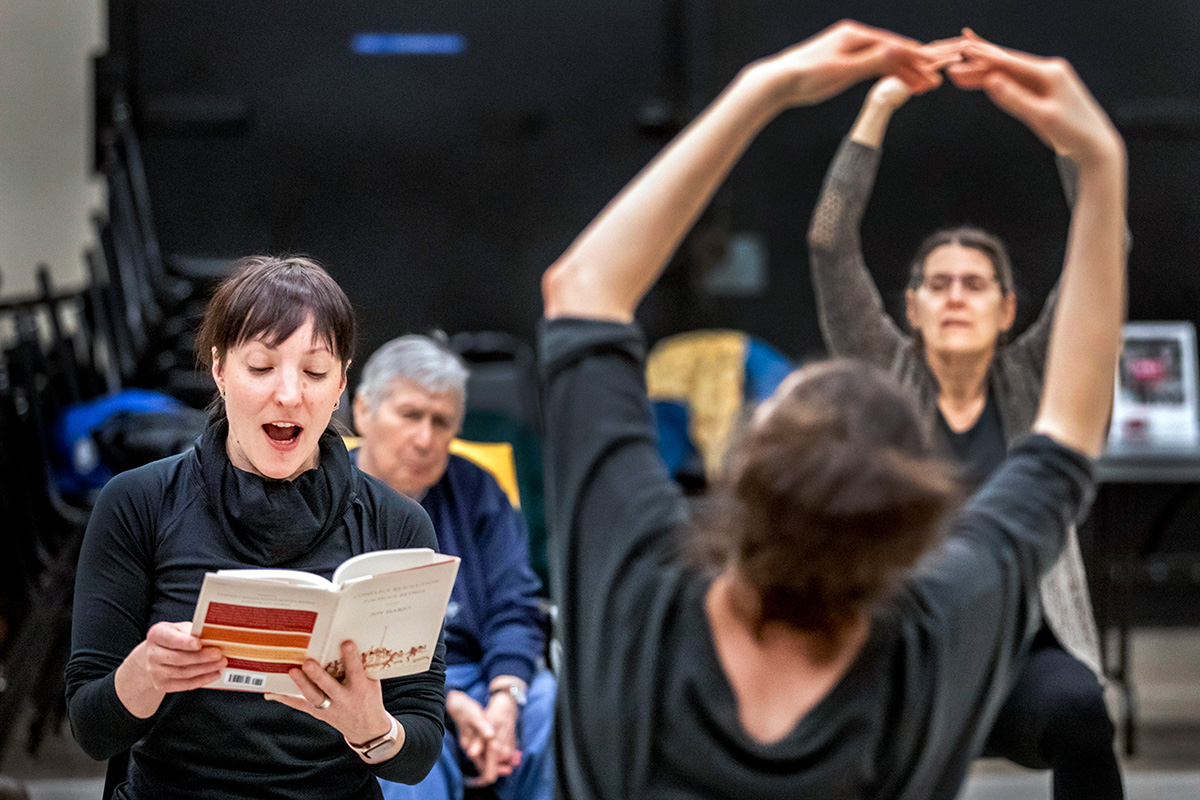
Laura Chiaramonte reads an excerpt from a book of poetry by Joy Harjo and the dancers move to the poem's rhythm.
Photo by Fred Zwicky
"Dance is an amazing movement therapy to deal with any kind of physical trauma," she says. "On top of that, it's fun."
When asked to improvise a dance move reflecting something he loves, another participant, Fred Coombs, makes a grand, sweeping gesture as he blows a kiss to his wife, Nancy, who graciously receives it with a wave. Others then mimic his motion. Fred laughs.
Coombs, 87, is a retired U. of I. education policy studies professor.
"It's marvelous," he says. "Getting into dance is very excellent for us. It gives us something to brighten our day."
The class dates back to November 2009, when staff from Krannert Center, Dance at Illinois, the Unity Parkinson's Disease Support Group and Carle Clinic began offering free dance sessions modeled on the Mark Morris pilot.
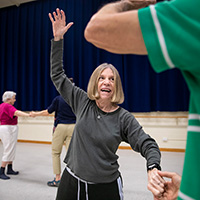
Maryly Crutcher joyfully jitterbugs across the dance floor. "It's a feeling of camaraderie," she says. "You feel like you're no longer alone. You see others doing well, and you know that you can, too."
Photo by Fred Zwicky
Instructors often improvise movements for the class to mimic. Co-instructor Kate Insolia says these brain teasers can be challenging but are a favorite of hers. The goal is to strengthen the body-mind connection, stretching the brain like a muscle. The movement prompts are similar to the familiar "rub your stomach while patting your head" challenge, just more inventive and artistic in nature. Laughter usually erupts during this portion of the class.
Research into the efficacy of dance therapy on Parkinson's shows two key benefits: a functional improvement from the movement exercises and a social benefit that derives from the supportive group interactions. Both instructors say the latter benefit cannot be overestimated.
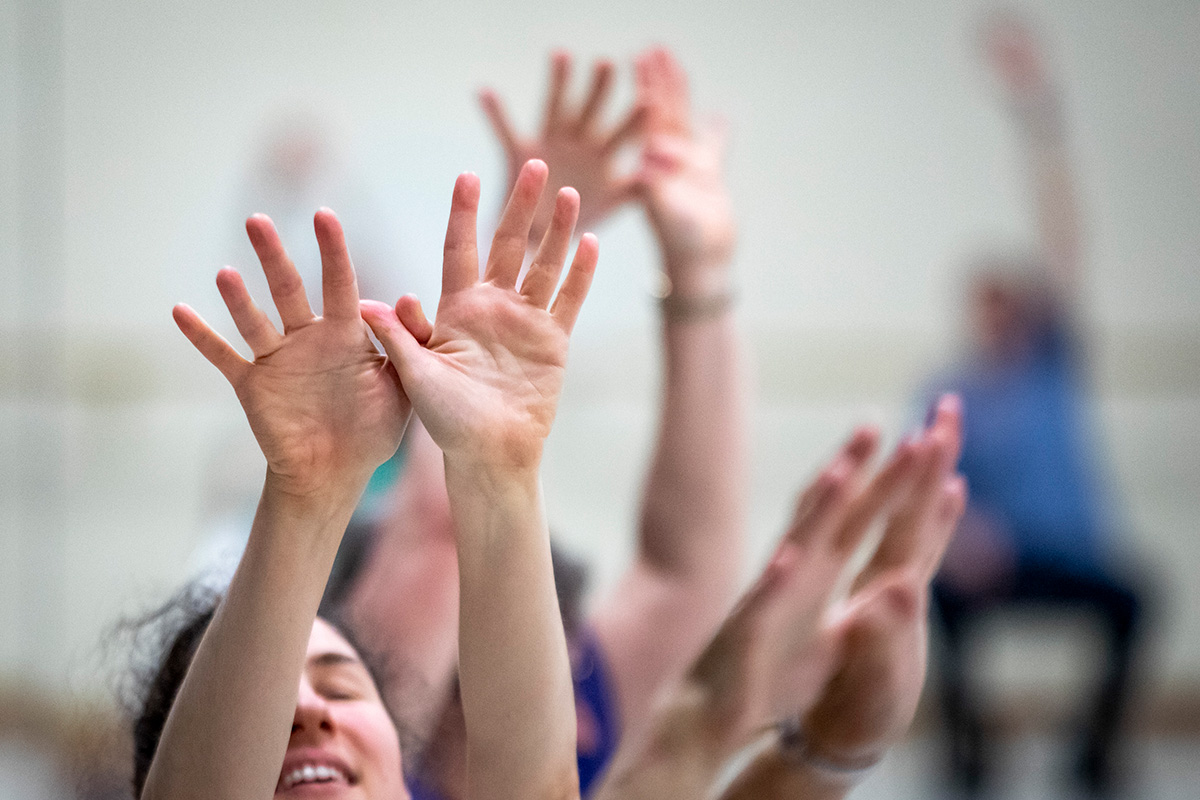
Fingers intertwined, Kate Insolia guides the dancers as they flutter their hands like birds.
Photo by Fred Zwicky
"It's a feeling of camaraderie," says dancer Maryly Crutcher, 74, a former program director at the Illini Union. "You feel like you're no longer alone. You see others doing well, and you know that you can, too."

As the class joins hands to celebrate its journey, Laura Chiaramonte, center in gray, bows to Dan Foote. Foote's dancing days go all the way back to the '60s when he presented traditional folk dances from cultures across the world as a member of the Illini Folk Art Society.
Photo by Fred Zwicky
Every session ends with the dancers forming a circle and joining hands as they each take a turn to bow to each other, celebrating their journey that day.

As participants head down winding passages at Krannert Center, Jim Kaler, front, receives a spontaneous hug of encouragement from a passerby. The monthly class is now on pause as the university responds to campus health and safety guidelines during the COVID-19 outbreak.
Photo by Fred Zwicky
Retired electrical engineer Gary Stitt, 61, sums up his new-found dance skills.
"You just have to keep moving, one way or another," he says. "If I ever stop moving, that's the end of it."
From her vantage point on the piano bench, Hillmer says, "I feel their energy to find expressive freedom. Life's not about being sick. Let's just do life, really, just celebrate what is still here."

